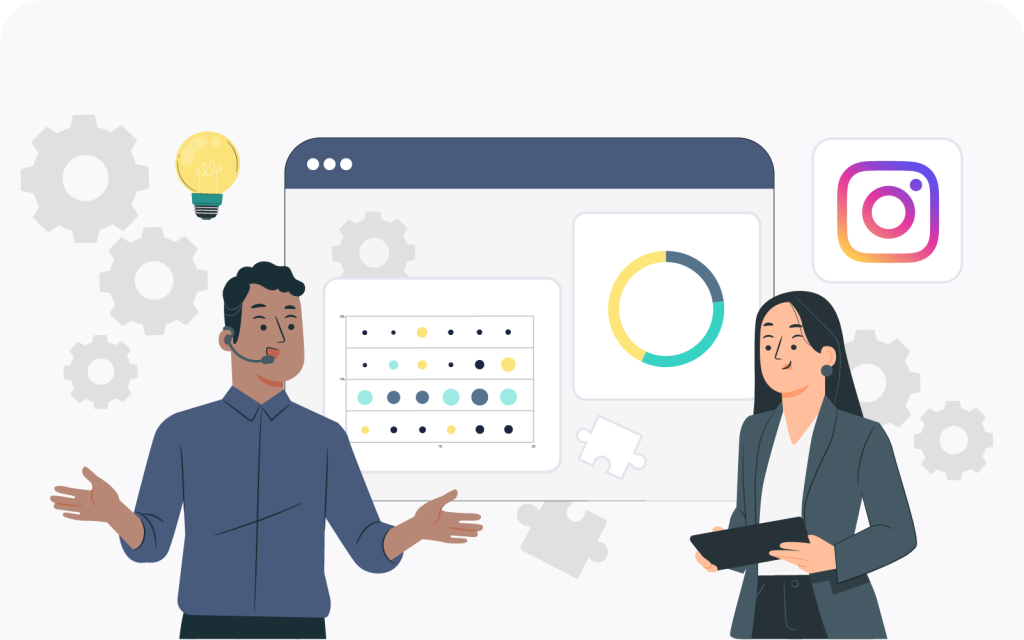The Best Hashtags for Facebook

So what are the best Facebook hashtags to use on your posts? The answer is, on the one hand simple and, on the other hand, not so straightforward. Ultimately, the Facebook hashtag you should be using on your posts depends on the topic you are posting about and what hashtags in your industry or niche are performing well for that topic. However, in order to find out what these hashtags are, you need to conduct Facebook hashtag research and analysis. In other words, finding the best performing Facebook hashtags for your profile should be based on your data analysis and not some gut feeling.
Understandably, you may be wondering how to do this? After all, you may have, up until this point, simply been using random hashtags that you think are going to help your post perform. If this is you, then you should be aware that you may not be using the right hashtags in your posts. In this article, we will highlight how you can use Facebook hashtag research and analysis to help you find what hashtags you should use to improve the performance of your posts.
Facebook Hashtag Research and Analysis
Many may look at overall Facebook hashtag trends as their primary means to select hashtags for their own posts. Studying these general trends can be helpful to see what hashtags might be popular at a given moment. However, looking for a hashtag to use on your Facebook reel, Story, or image, etc., shouldn’t be driven by what is trending in general, but rather needs to be focused on the particular theme or topic that your posts relate to.
One other point to keep in mind is that Facebook hashtag trends are generally focused on the reach associated with particular hashtags, not whether they correlate with a high post-interaction rate within your industry. This is important since many businesses or individuals who are posting on Facebook want their audience to interact with the post, whether it is through a like, comment, or share.
While some may think that hashtag research is simply looking up general trends, we will introduce a data-drive approach to Facebook hashtag research and analysis. In doing so, we are going to focus heavily on the process of finding the best hashtags for your Facebook posts. In explaining each step of this process, we share some best practices that you should keep in mind when conducting your Facebook hashtag research.

In going through these Facebook hashtag best practices, we don’t want to keep the conversation purely theoretical. For this reason, we are going to provide a real-life example to help illustrate how the process should work. As you probably know, coffee shops are quite popular in the U.S. (and, of course, many other places), so let’s pretend that we want to open up our own coffee shop chain. As an approach to gain more brand awareness in the U.S., our (imaginary) coffee shop chain wants to use the best Facebook hashtags for our posts that drive engagement.
In our scenario, we will focus on U.S.-based coffee shop chains, which means those that have their headquarters in the U.S. Additionally, we will only be analyzing their main Facebook accounts, which excludes any individual local accounts that focus only on a specific town or small area. Lastly, we have chosen coffee shop chains that operate in more than one state, which means they are present in a specific region or are located throughout the country. The Coffee shop chains we have chosen for our analysis are: Biggby Coffee, Black Rock Coffee Bar, Caribou Coffee, Coffee Beanery, Dutch Bros Coffee, Starbucks, The Coffee Bean & Tea Leaf, and The Human Bean.
Below, we take you through the step-by-step process of finding the best hashtags for your Facebook posts by analyzing the hashtag activities of the coffee shop chains above. This will allow us to see what hashtags we should consider using in our own posts. In doing so, we will be using the all-in-one social media tool Fanpage Karma to analyze our data. All of the graphs, tables, and charts you will see below are generated by this tool.
Step 1: Decide on the Profiles you want to Analyze
In conducting Facebook hashtag research, you obviously want to find hashtags related to coffee that will help your coffee shop train get noticed. These “coffee hashtags” would preferably correlate with high post-interaction rates, which would help our new brand get noticed and have people interact with our content.
There is a lot to consider when adding other profiles to your data set for analysis. This is because deciding on the profiles you want to analyze is essential for accurate Facebook hashtag tracking. To begin, you should keep in mind that the profiles you add to your data set should all be related to the same industry or topic-niche and post similar content to your own. In the case of coffee shops, you want to make sure that profiles you are adding to your analysis are posting about topics and themes related to coffee shops in particular and popular coffee topics in general.
The second factor to consider is the location of these companies, namely WHERE they are operating. As we said, our example focuses on the U.S. as a whole, but there are also regional and national coffee shop chains that are not national brands. If you are focusing on only a city or region, you may not necessarily want the main Facebook profile of Starbucks in your data set. This is because, as a coffee shop chain operating only within a single city or relatively small region, there can be regional or local trends that you may miss if you add mostly national-focused profiles to your data set.
In sum, in order to accurately study Facebook hashtag trends within your industry, you need to focus both on the content and location of the profiles in your analysis. By having a focus, your Facebook hashtag research will most likely yield much better results than if you don’t put much thought into compiling your data set.

Step 2: Identify the Time Period you are Interested In
Coffee interests many people and is, clearly, a popular beverage worldwide year round. However, similar to other industries, there are trends that correlate to a specific time of the year. For instance, it’s not a secret that pumpkin flavors in coffee are popular during the Fall. Moreover, there can be other coffee hashtag trends that we see during the Summer or Winter, for example. So how does this affect your data analysis?
The best Facebook hashtag for your posts will be dependent on the time period you want to post in. This is where historical data is important, especially if you are trying to understand Facebook hashtag trends for a particular time of year. For instance, you may want to get a jump on hashtags that may be trending in the Fall 2024 and the different coffee flavors that are promoted during this time (more on this later). The solution would not be to simply study the hashtags used in the last three or six months, but rather the hashtags from a specific time period in 2023 (for instance in September).
To highlight how consequential this point is, we will show to what extent your data output is changed if you are analyzing the same profiles in your data set, but are studying two different time periods. We will now look at the top Facebook hashtags from July 2023 and then compare them with the top hashtags from December 2023.
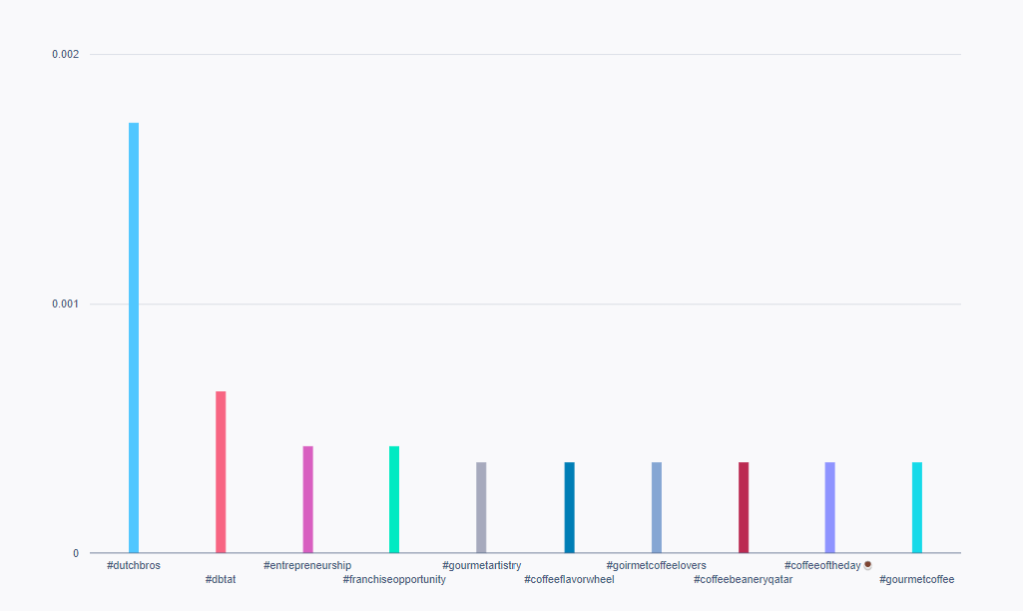
(July 2023)
As shown above, this bar chart shows highly performing Facebook hashtag trends for a particular time period in the coffee shop chain industry (in this case July 2023). Of course, when studying the results above, you would look first at the non-branded hashtags on this list since branded hashtags associated with a particular coffee shop chain will also appear in your results. However, the main question relating to our example here is if December (a.k.a. the Christmas season) has a real effect on the top hashtags in terms of post-interaction rate?
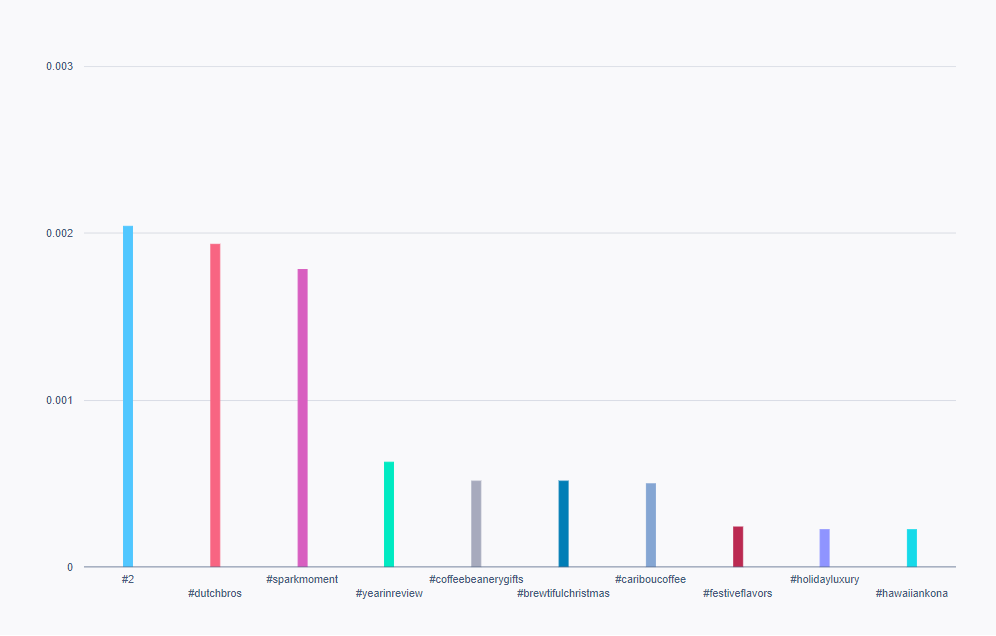
(December 2023)
Even by just quickly comparing the bar charts above, we notice a change in the Top 10 best Facebook hashtags for post interaction in December 2023 as compared to July 2023. While this example is relatively simplistic, it does a good job of showing that different times of the year can change your data set, analysis, and findings.
Step 3: Run your Data Analysis and Study the Output
Once you determine what profiles you will include in your data set as well as the timeframe you are interested in, it is time to study the data output. The Fanpage Karma tool, for example, provides you with some different options in this regard. You may want to see a chart that shows only hashtags corresponding to high relative post interaction rates. Alternatively, you may want to expand your data output to provide an overview of all hashtags used by profiles in your data set. You can then search for the best hashtags according to a specific metric, such as those getting the most likes or comments.
To start, let’s look at the example we mentioned above about how some particular coffee flavors or trends may appear in the lead-up to Fall. In looking at historical data from August-September 2023, we want to illustrate the different types of analyses you can look at, to help you make an informed decision about what hashtags you will use in your content creation.
The first approach is to look at key metrics of all hashtags used for the profiles in your data set in a specific time period. As shown by the metric table below, you can see the metrics of individual hashtags which include the post per day with that hashtag, the number of likes and/or comments, as well as the post interaction rate.

(August-September 2023)
This approach provides you with many different data points since there are, of course, dozens if not hundreds of hashtags used in a specific industry on a monthly basis. Another approach you can consider using is simply looking at the hashtags with the highest post interaction rates for a given time period.
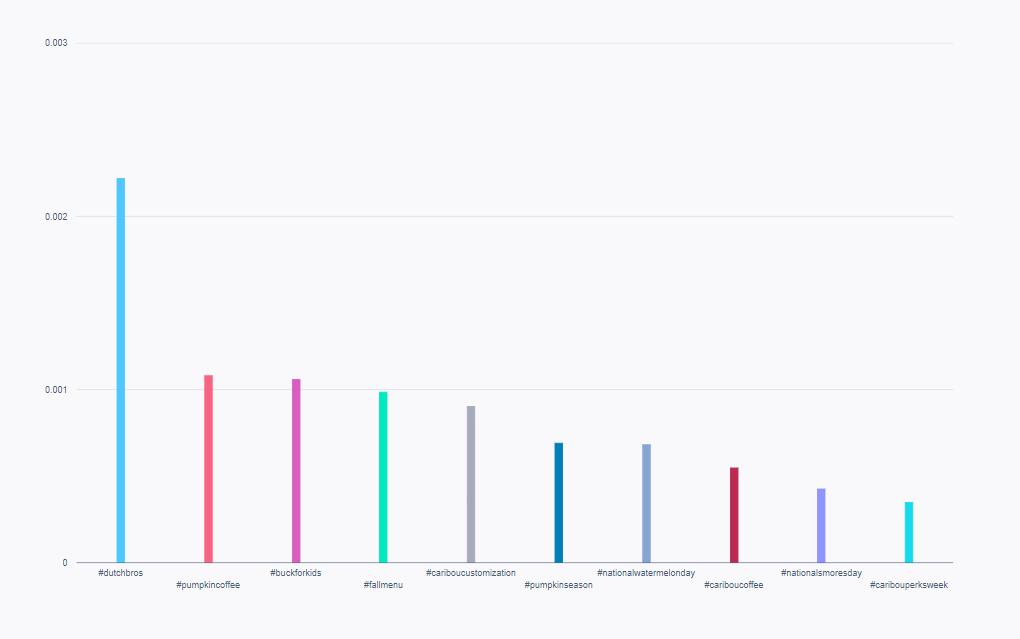
(August-September 2023)
The approach you see above is on the other end of the spectrum regarding your data output in that it is very focused and gives you an instant view into what hashtags have high post interaction rates.
However, you may be concerned not only with the post-interaction rate, but where there may be less competition for high-performing hashtags. In this scenario, you may want to consider the word chart for your data output. In fact, one of the Facebook hashtag best practices we can recommend in this case is looking for hashtags that have, an average, a high post interaction rate but also are not used frequently.
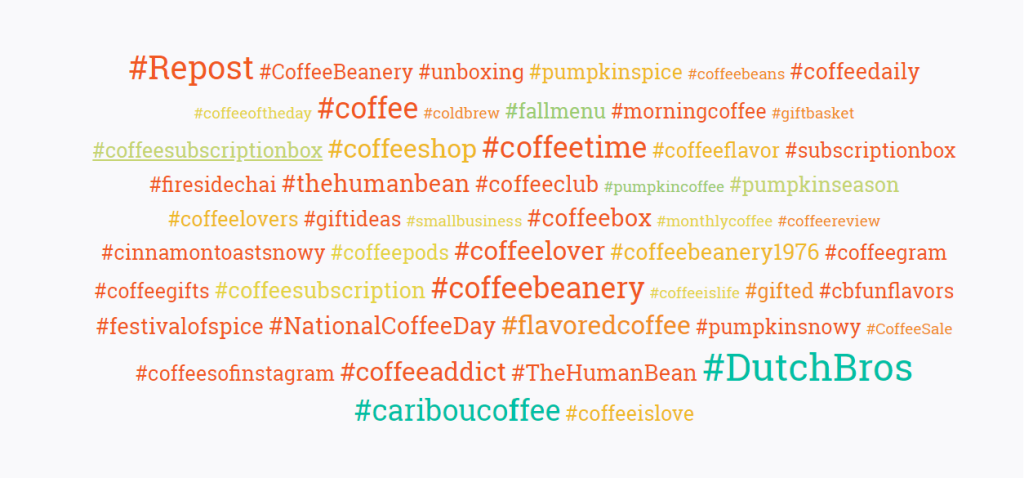
(August-September 2023)
As you see above, when a word is green, this means it has a higher relative post interaction rate and the actual size of the word in the chart indicates how often it is used in a given time period (larger words more often and smaller words least often). In this case, the best hashtag for your Facebook post may not be the one with only the highest post-interaction rate, but the one with a high post-interaction rate AND is not used constantly.
One last point to include here is, as we already mentioned in Step 1, that you may only want to focus on specific, regional Facebook profiles. Individual coffee shops that are part of chains may have their own local Facebook profile, and it may make sense to focus on competitors in your local area rather than on national profiles. As we have already demonstrated, changes to your data set in terms of the profiles you are tracking as well as the time period you are analyzing can alter your data output. Therefore, you should also be aware of what you want to track, depending on your market side and the competitors you wish to analyze.
Step 4: Implement your Findings into your Hashtag Strategy and Monitor the Results
Discovering relevant Facebook hashtag trends is only part of the battle. Additionally, you should also integrate your findings into your social media content plan. Make sure that the content you are producing actually relates to the highly performing hashtags you found. If your content is not relevant for the hashtag, you may not see the results you want.
You should also monitor how things can change over time, whether it is because of the season or if there is a new trend or topic that relates to your industry. Facebook hashtag tracking is important in order to see what is trending at a given time and how topics are developing in your niche over time. For these reasons, social media tools can be valuable not only for tracking hashtags over time, but also for keeping up on the latest trends. Additionally, social media tools can also enable a more advanced benchmarking analysis which helps you compare your performance to that of your competitors.
Lastly, it is important to monitor your performance not only for hashtags, but also your other activities. Social media tools can give you additional insights into your overall performance, which helps show you if your hashtag activities are making a difference. Moreover, social media tools give you capabilities such as finding the best posting times or managing your communities.
Conclusion: Facebook Hashtag Research and Analysis
Hashtags will magically improve your content performance that is not created for the right target audience. Nor are using the right hashtags alone sufficient for high engagement rates. However, finding the best Facebook hashtags for your posts can be used to your advantage. In order to effectively carry out Facebook hashtag research and analysis, you need to put thought into the profiles and time period you want to track.
If you want to conduct hashtag research yourself, Fanpage Karma offers a free 14-day trial of their all-in-one social media tool. With this tool, you can conduct hashtag analysis not only on Facebook but also other social media networks such as Instagram, Twitter, TikTok, etc. This is in addition to industry-leading benchmarking, publishing, community-management, and research features.
There is also a free weekly webinar that shows you how to use this all-in-one social media tool.




